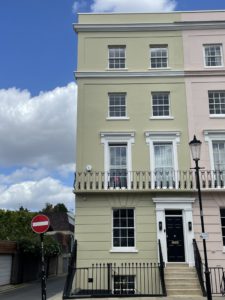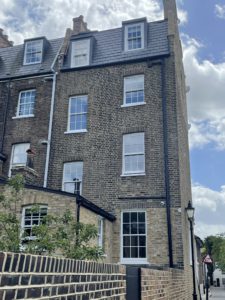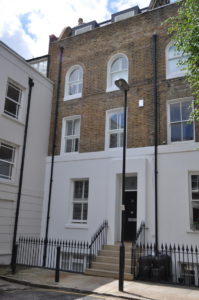
Conservation Area Windows
Windows for Conservation Areas
The British Isles are bursting at the seams with charming period buildings and grand historic monuments. Some of the UK’s landmarks, such as Big Ben, Tower Bridge, or Buckingham Palace, are known all over the world and attract millions of tourists every year. Other, less famous ones please mainly the eyes of the locals. All of them, however, are equally worth preserving in their original form. To prevent people from making major alterations that could disrupt the cohesive architectural style of the building, adequate protection was needed. That’s why conservation areas came into play. What are they and what function do they serve?
What are conservation areas?
In the UK, conservation areas were first introduced in the 1960s. Their goal is to protect and preserve buildings and open spaces of high historic value. Whenever a place of architectural interest is identified, the local planning authority designates a conservation area. To this day, as many as 10,000 of them have been created across the country. The vast majority of them are located in England – mostly in Wiltshire, Cornwall, and the Cotswold district. Once a conservation area is designated, all properties within it become subject to several regulations concerning making any repairs or changes. How does it affect the residents?
If you live in a conservation area, changing windows or doors in your building can pose a serious problem. To make such an alteration, you need to first obtain planning permission from the authorities. Carrying out any work without it would in most cases be considered a planning breach. You could be forced to revert any introduced changes or even prosecuted. And even with permission, you cannot install any doors or windows you find suitable. They need to match the architectural style of the building – and preferably look just like the ones you plan on replacing. This is why it’s essential to find a company that will be able to provide you with bespoke windows created in accordance with your instructions.
Perfect windows for conservation areas
At Sash Factory, we offer premium-quality windows for conservation areas. London alone has almost 30 such places, which is why the demand for conservation windows in this city is so strong. Changing windows in conservation areas can be problematic, but with our qualified team, you’ll have nothing to worry about. We can provide you with wooden conservation windows of all popular types. Since many buildings located in historic areas date back to the 18th or 19th century, windows for conservation areas must often be exact copies of Georgian-, Victorian-, or Edwardian-era windows. What are the most commonly installed conservation area windows in London?
Casement conservation windows
As such, casement windows were the first ones that could actually open to let in the fresh air. Their contemporary form, however, dates back only to the 18th century. Although traditionally, they open outwards, inward-opening casement windows have also been installed in some buildings. Moreover, they come in a number of variants, including French, single-frame, or flush casement windows. This diversity may seem overwhelming if you’re considering replacing your conservation area windows, but fortunately, you don’t need to be a joinery expert yourself to commission a set of windows that’ll match the architectural style of your building. All you need is a team of professionals who will provide you with a bespoke copy of your current conservation windows.
If you’re thinking about changing windows in a conservation area in London, order them at Sash Factory. We specialise in bespoke joinery, including casement windows of different subtypes and sizes. We can provide you with casement windows that will be faithful copies of your previous ones, and at the same time will have excellent acoustic and thermal properties, characteristic of modern, technologically advanced products. Their advantages also include increased airtightness, greater security and optimum energy efficiency that can positively influence your heating bills. Replacing windows in a conservation area no longer has to be a major headache.
Sash conservation area windows
Sash windows were first invented in London, in the 17th century, but quickly gained popularity among architects in the entire country and retained it through the Georgian, Victorian and Edwardian eras. They were a great alternative for outward-opening casement windows that took up too much space in the narrow streets. Interestingly, sash windows from each of the three periods differ from one another in terms of design. The oldest ones typically featured sashes divided into six or more symmetrically arranged parts. Victorian sash windows were larger and had fewer muntin bars, while Edwardian windows combined the two approaches, placing multiple smaller panes on the upper sash and leaving the bottom one undivided. Whichever type of sash conservation area windows you want to replace, Sash Factory will measure up to your expectations.
Sash windows are almost ubiquitous in conservation areas in London. Although originally rather draughty, modern sash conservation windows offered by Sash Factory are airtight and much more energy-efficient, which makes them an excellent replacement. Our sash windows for conservation areas will be equally charming and elegant as the original ones, while at the same time they will prevent you from excessive heat loss and be more resistant to mechanical damage. In some conservation areas, it may also be permissible to commission double-glazed sash windows. This way, you’ll ensure that their thermal properties will be even better. Thanks to that, the problematic change of windows in a conservation area will truly be worth the trouble.
Conservation roof windows
Some buildings located in conservation areas have also, apart from regular windows, roof windows. They are, naturally, the ones installed on the roof, at a 15- to 90-degree angle, so that more natural light can pour into the room. Conservation roof windows differ from the standard ones only in that they must comply with planning regulations and correspond to the architectural style of the given property. They may seem more challenging to replace, since they are incorporated in the structure of the roof, but for an expert team such as ours, changing roof windows in a conservation area will pose no problem.
uPVC or wooden conservation windows – which are better?
Although plastic window frames have a number of advantages, such as more attractive price or low maintenance, they always stand out against the facade of a period building. In some conservation areas, plastic windows are permitted as long as they don’t disrupt the architectural style of the building. The truth is, however, that wooden conservation windows are a much better choice. Timber is the perfect building material for bespoke conservation replacement windows, since that’s what the original ones were made of. This way, not only the design, but also the material of the new products will match the previous wooden conservation windows. London is home to many window manufacturers and distributors, but if you’re planning on changing windows in a conservation area, make sure to choose a true expert.
Sash Factory – conservation windows and more
At Sash Factory, we have gained much valuable experience in bespoke window installation – including conservation windows. London is our base, and we have successfully carried out numerous projects in the city centre as well as in the suburbs. Whether you need new casement, sash, or conservation roof windows, London is where you should start searching. Reputable timber window providers, such as Sash Factory, can refit your house with premium-quality products that will fully satisfy your needs and comply with the regulations of your conservation area. You can contact us to request an individual quote. Depending on the complexity of your order, the lead time will be between 6 and 20 weeks.



